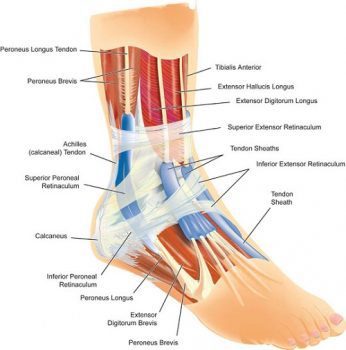Among the large variety of athletes, an ankle sprain is one of the most common musculoskeletal injuries. According to research, a considerable amount of sports-related injuries may be caused due to ankle instability, also known as ankle ligament laxity.
Table of Contents
Factors for Ankle Sprains
The most frequent factor behind a majority of ankle sprains is when a single extremity lands on an uneven surface. During this case, a quick and joined ankle plantar flexion and inversion motion can often result in an extreme lateral movement which can lead to ankle sprains. Another factor that can influence the chance of lateral ankle sprains is proprioception, or an individual’s own neuromuscular control. With the necessary proprioception, an athlete may be able to accurately determine the speed and force of a disturbance of motion in order to be able to subsequently react with an appropriate joint and muscle motion to avoid injury. However, because there’s always a chance the athlete may be surrounded by uneven terrain, even an individual with excellent proprioceptive skills can suffer harm. Moreover, the evidence for the role of proprioceptive factors in preventing ankle sprains is still unclear. Other factors which may lead to ankle sprains among athletes included non-modifiable risk factors such as: sex, age, height, race, foot/ankle anatomy, extremity alignment, previous ankle sprain and generalized joint laxity. Modifiable risk factors that can cause an ankle sprain include: weight, body mass index, bracing/taping, footwear, neuromuscular control, postural stability, muscle strength, exposure to sport, player position, playing surface and skill level.
Due to the nature of lateral ankle sprains, once an individual has experienced an injury, there’s a high probability that another injury can occur. This is because damage or injury to the ligaments and joint capsules within the ankle can impair the structures ability to function appropriately. Along with any deficits in proprioception, this can often result in a high re-injury rate. Indeed, research has demonstrated that 73 percent of individuals who sprain their ankles are most likely to experience recurrent ankle injuries in the future.

The Importance of Balance
As previously mentioned, numerous researchers have proposed that both neuromuscular control and proprioception of the ankle joint is a considerable factor in the initial and recurrent cause of ankle sprains. Furthermore, despite decades of studies on ankle sprains, the evidence remains inconclusive. More specifically, research has failed to find actual evidence that suggests individuals with ankle instability may experience proprioception deficits compared to those without a history of ankle instability because there is no standard testing and training protocol for determining ankle proprioception.
Many healthcare professionals believe that balance issues and an impaired proprioception can play a significant role when it comes to ankle sprains. These are common components of many intervention programs for the prevention and treatment of acute lateral ankle sprains and chronic ankle instability. Moreover, a considerable amount of contemporary theory on this subject suggests that balance and coordination training may have both local and central effects on the sensorimotor system, or a subcomponent of the comprehensive motor control system of the body.
In a 2008 review study performed to provide a better understanding behind proprioception, balance and ankle sprain, the following questions were issued to answer various doubts regarding the issue:
- Can prophylactic balance and coordination training reduce the chance of experiencing a lateral ankle sprain?
- Can balance and coordination training improve the result of treatments associated with acute ankle sprains?
- Can balance and coordination training improve the result of treatments in patients with chronic ankle instability?
In total, the results of eleven studies were combined; three of which were used to answer question 1, three to answer question 2 and five to answer question 3. The researchers finally determined that prophylactic balance and coordination training essentially reduced the chance of athletes suffering ankle sprains, more closely observed among those with prior sprains. There was also further evidence that completing at least 6 weeks of balance and coordination training during recovery from an acute ankle sprain could potentially reduce the risk of frequent ankle sprains for up to one year.
Although a variety of studies determined the above facts, the researchers also noted that the improvements in the postural control instrumented measures associated with the training were not regularly calculated from study to study, which ultimately reduces the quality of the evidence. They also mentioned that there was not enough evidence to accurately assess the reduction in the chance of experiencing repeated sprains, inconclusive to demonstrate improved instrumented postural control measures and limited towards the development of an athlete’s functions with chronic ankle instability or ankle ligament laxity who also complete balance and coordination training.
The findings of the above study were also relevant with a very recent study regarding ankle sprains among the athletic population. This study recognized that a change in neuromuscular control as a result of peripheral proprioception alterations of the ankle joint may in fact contribute to the high frequency of lateral ankle sprains and that after the initial injury, overstretched and/or loosened ligaments and joint capsules may restrict the function of the mechanoreceptors in those structures. It also demonstrates that some researchers have reported prolonged peroneal muscle reflex latency in injured ankles and ankle position sense deficits in various testing protocols.
However, the researchers from the study also showed that regardless of the provided evidence, there are also many studies which have been conducted that contradict these findings. For instance, in several studies that compare healthy and unstable ankles, no peroneal reflex latency differences, no position sense differences, and no movement sense differences were found between the two various ankles studies. Additionally, some studies indicate that the ability to sense ankle position is not recommended to be used for predicting ankle sprains in the future.
Strength and Balance
With that mentioned, a majority of the provided evidence appears to be contradictory, at least in the sense where balance training is not believed to improve the prediction of ankle sprains and reduce the risk of repeated injury, regardless if there’s a small amount of evidence that shows how improving an individual’s neuromuscular control can produce positive results. This could be because even with better, almost intact proprioception at the ankle joint, generating enough muscle strength that is fast enough to counter the wide variety of quick disturbances of motion, such as landing on an uneven surface, still remains an issue.
One likely consideration for the examination is the role of strength. A recent study has indicated that developing sufficient muscle strength could indeed play a much more essential role in the prevention and rehabilitation of ankle sprains rather than improving proprioception. Although the effects of muscle strength on ankle stability is yet unclear, muscle weakness has been reported in peroneal muscles, ankle dorsiflexes, and hip abductors among many individuals with ankle instability.
Although stimulating large muscles can enhance the sensitivity of muscle spindles, strength training is not proven to reduce the chance of initial and recurrent ankle sprains through enhancing neuromuscular control of the ankle joint. It can help restore ankle muscle balance, however, as well as better position the ankle and increase the strength of the ligaments. In addition, a larger and stronger muscle can also provide additional passive restraints to the ankle joint.
Therefore, if balance training is beneficial in reducing ankle sprains, it is most likely because of the enhanced strength and stiffness in both muscles and ligaments at the ankle joint rather than enhanced neuromuscular control. In other words, while improving neuromuscular control and proprioception at the ankle joint may not be effective towards protecting the ankle from an accident, balance training can increase the strength of muscles and ligaments around the ankle joint. Since ligaments are the primary stabilizer of the ankle joint, treatment protocols with a balance training routine may benefit the athletes with unstable ankles.
In conclusion, it appears that ankle injury prevention and rehabilitation programs which focus primarily on proprioception improvement may not be as effective afterall. The evidence that proprioceptive training can benefit the prevention of an injury or recurrence is not considered to be strong enough. However, the evidence for balance training is much stronger, although the benefits are most likely to occur as a result of improvements in muscular and ligament strength.
For more information, please feel free to ask Dr. Jimenez or contact us at 915-850-0900 .
Preventing Sports Injuries
Sourced through Scoop.it from: www.elpasochiropractorblog.com
By Dr. Alex Jimenez
Post Disclaimer
Professional Scope of Practice *
The information on this blog site is not intended to replace a one-on-one relationship with a qualified healthcare professional or licensed physician and is not medical advice. We encourage you to make healthcare decisions based on your research and partnership with a qualified healthcare professional.
Blog Information & Scope Discussions
Welcome to El Paso's Premier Wellness and Injury Care Clinic & Wellness Blog, where Dr. Alex Jimenez, DC, FNP-C, a board-certified Family Practice Nurse Practitioner (FNP-BC) and Chiropractor (DC), presents insights on how our team is dedicated to holistic healing and personalized care. Our practice aligns with evidence-based treatment protocols inspired by integrative medicine principles, similar to those found on this site and our family practice-based chiromed.com site, focusing on restoring health naturally for patients of all ages.
Our areas of chiropractic practice include Wellness & Nutrition, Chronic Pain, Personal Injury, Auto Accident Care, Work Injuries, Back Injury, Low Back Pain, Neck Pain, Migraine Headaches, Sports Injuries, Severe Sciatica, Scoliosis, Complex Herniated Discs, Fibromyalgia, Chronic Pain, Complex Injuries, Stress Management, Functional Medicine Treatments, and in-scope care protocols.
Our information scope is limited to chiropractic, musculoskeletal, physical medicine, wellness, contributing etiological viscerosomatic disturbances within clinical presentations, associated somato-visceral reflex clinical dynamics, subluxation complexes, sensitive health issues, and functional medicine articles, topics, and discussions.
We provide and present clinical collaboration with specialists from various disciplines. Each specialist is governed by their professional scope of practice and their jurisdiction of licensure. We use functional health & wellness protocols to treat and support care for the injuries or disorders of the musculoskeletal system.
Our videos, posts, topics, subjects, and insights cover clinical matters and issues that relate to and directly or indirectly support our clinical scope of practice.*
Our office has made a reasonable effort to provide supportive citations and has identified relevant research studies that support our posts. We provide copies of supporting research studies available to regulatory boards and the public upon request.
We understand that we cover matters that require an additional explanation of how they may assist in a particular care plan or treatment protocol; therefore, to discuss the subject matter above further, please feel free to ask Dr. Alex Jimenez, DC, APRN, FNP-BC, or contact us at 915-850-0900.
We are here to help you and your family.
Blessings
Dr. Alex Jimenez DC, MSACP, APRN, FNP-BC*, CCST, IFMCP, CFMP, ATN
email: coach@elpasofunctionalmedicine.com
Licensed as a Doctor of Chiropractic (DC) in Texas & New Mexico*
Texas DC License # TX5807
New Mexico DC License # NM-DC2182
Licensed as a Registered Nurse (RN*) in Texas & Multistate
Texas RN License # 1191402
ANCC FNP-BC: Board Certified Nurse Practitioner*
Compact Status: Multi-State License: Authorized to Practice in 40 States*
Graduate with Honors: ICHS: MSN-FNP (Family Nurse Practitioner Program)
Degree Granted. Master's in Family Practice MSN Diploma (Cum Laude)
Dr. Alex Jimenez, DC, APRN, FNP-BC*, CFMP, IFMCP, ATN, CCST
My Digital Business Card

